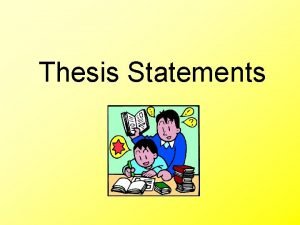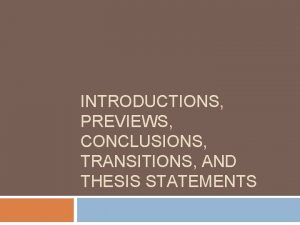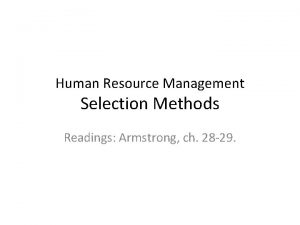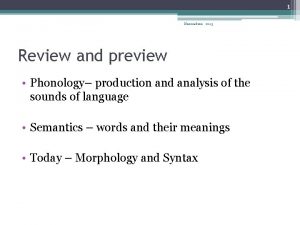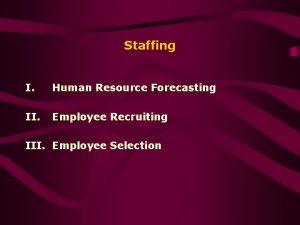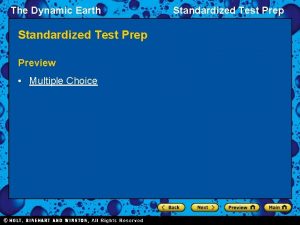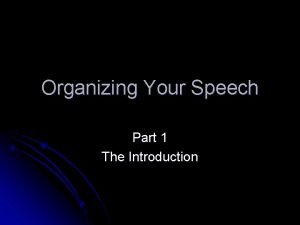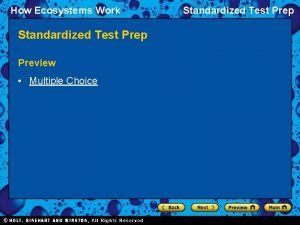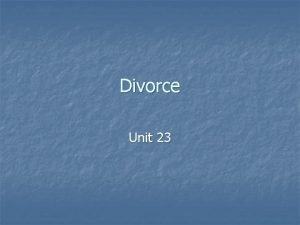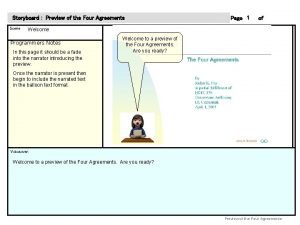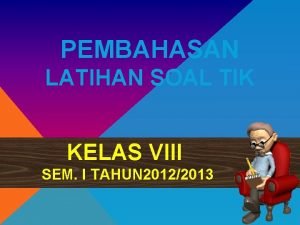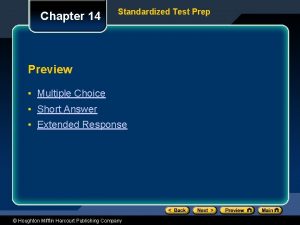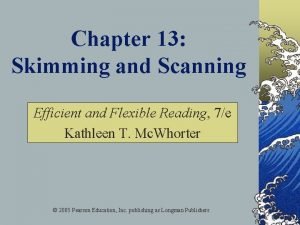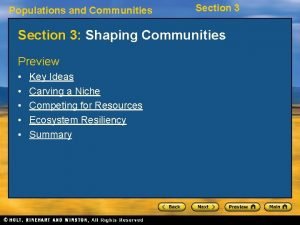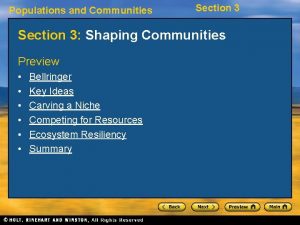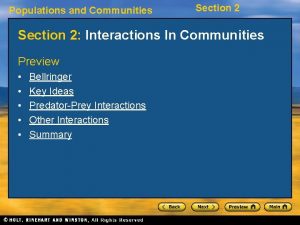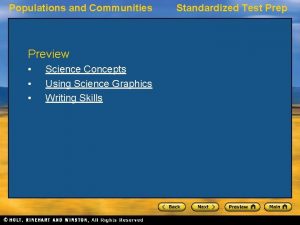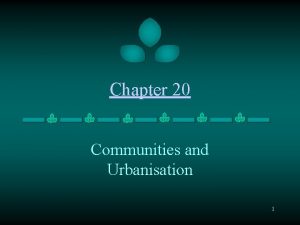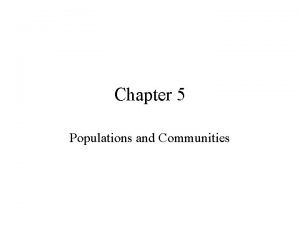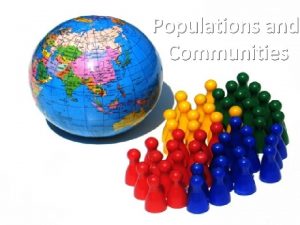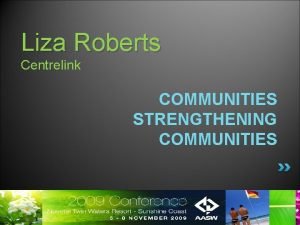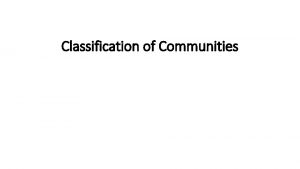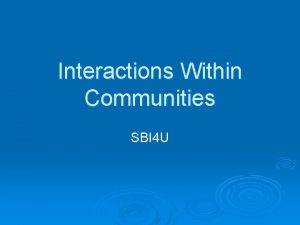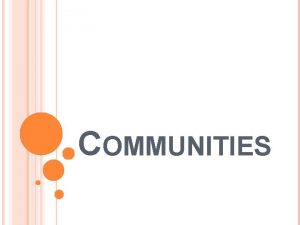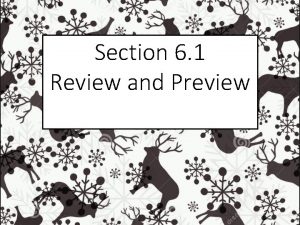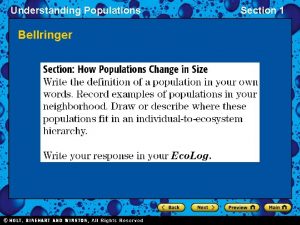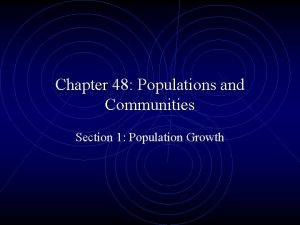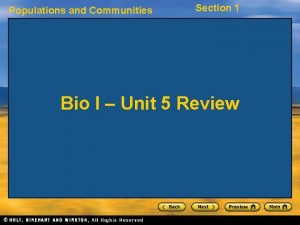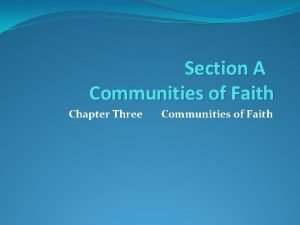Populations and Communities Section 1 Populations Preview Section























- Slides: 23

Populations and Communities Section 1: Populations Preview Section 1

Populations and Communities Section 1 What Is a Population? • A population is made up of a group of organisms of the same species that live together in one place at one time and interbreed. • Populations may grow, decline, or remain the same. • Understanding how populations of different species interact is important.

Populations and Communities Visual Concept: Population Section 1

Populations and Communities Section 1 Population Growth • Whether a population grows or shrinks depends on births, deaths, immigration, and emigration. • Immigration is the movement of individuals into a population. • Emigration is the movement of individuals out of a population.

Populations and Communities Section 1 Population Growth, continued • A simple population model describes the rate of population growth – Based on birthrate, death rate, immigration, and emigration. • Plotting population changes against time on a graph creates a model in the form of a curve.

Populations and Communities Section 1 Two Population Growth Models

Populations and Communities Section 1 Population Growth, continued • Exponential growth • Population size grows slowly when it is small. But as the population gets larger, growth speeds up. • This type of increase causes the J-shaped curve of exponential growth.

Populations and Communities Section 1 Visual Concept: Exponential Growth

Populations and Communities Section 1 Population Growth, continued • Factors such as availability of food, predators, and disease limit the growth of a population. • Eventually, population growth slows and may stabilize. • An ecosystem can support only so many organisms. • Carrying capacity – The largest population that an environment can support at any given time

Populations and Communities Section 1 Population Growth, continued • Density-dependent factors are variables affected by the number of organisms present in a given area. – Area to live, food • Density independent factors are variables that affect a population regardless of the population density. – weather, floods, and fires.

Populations and Communities Section 1 Population Growth, continued • Logistic growth is population growth that starts with a minimum number of individuals and reaches a maximum depending on the carrying capacity of the habitat. • When a population is small, the growth rate is fast because there are plenty of resources. • As the population approaches the carrying capacity, resources become scarce.

Populations and Communities Section 1 Visual Concept: Limiting Factors and Carrying Capacity Click above to play the video.

Populations and Communities Section 1 Population Growth, continued • Competition for food, shelter, and mates increases between individuals of a population. As a result, the rate of growth slows. • The population eventually stops growing when the death rate equals the birthrate. • On a graph, logistic growth is characterized by an Sshaped curve.

Populations and Communities Section 1 Visual Concept: Logistic Model

Populations and Communities Section 1 Factors That Affect Population Size • Many factors cause populations to grow and shrink. Water, food, predators, human activity, etc.

Populations and Communities Section 1 Factors That Affect Population Size, continued • abiotic factors – Nonliving factors that affect population size – Weather and climate • biotic factor – related to the activities of living things – Food, such as grass or other animals – density dependent

Populations and Communities Section 1 Factors That Affect Population Size, continued • As the density of a population increases, the effects of starvation, predators, and disease often also increase. • Humans affect populations of many species by disrupting habitats, introducing diseases, or introducing nonnative species.

Populations and Communities Section 1 Human Population • Today, the world population is more than 7 billion people and is increasing. • Better sanitation and hygiene, disease control, and agricultural technology are a few ways that science and technology have decreased the death rate of the human population. • As more humans live on the planet, more resources will be needed to support them. As demand for resources increases, more pressure will be put on Earth’s ecosystems.

Populations and Communities Section 1 Human Population, continued • For most of human history, there have been fewer than 10 million people. • Two thousand years ago, there were only 300 million people. Around the time of the Industrial Revolution (late 1700 s), the human population started to accelerate rapidly.

Populations and Communities Human Population Growth Section 1

Populations and Communities Section 1 Human Population, continued • Science and technology are major reasons why the human population is growing so rapidly. • Advances in agricultural technology have allowed efficient production of crops and other foods. • Medical advances lower death rate and increase life expectancy.

Populations and Communities Section 1 Summary • Understanding population growth is important because populations of different species interact and affect one another, including human populations. • Exponential growth occurs when numbers increase by a certain factor in each successive time period. Logistic growth is population growth that starts with a minimum number of individuals and reaches a maximum depending on the carrying capacity of the habitat.

Populations and Communities Section 1 Summary, continued • Water, food, predators, and human activity are a few of many factors that affect the size of a population. • Better sanitation and hygiene, disease control, and agricultural technology are a few ways that science and technology have decreased the death rate of the human population.
 Types of ecological succession
Types of ecological succession Thesis examples
Thesis examples Thesis statement in summary
Thesis statement in summary Thesis and preview statement example
Thesis and preview statement example Realistic job preview advantages and disadvantages
Realistic job preview advantages and disadvantages Review and preview
Review and preview Benefits of hr forecasting
Benefits of hr forecasting Evolution of populations section 16-1 genes and variation
Evolution of populations section 16-1 genes and variation Evolution of populations section 16-1 genes and variation
Evolution of populations section 16-1 genes and variation Test prep preview
Test prep preview Test prep preview
Test prep preview Test prep preview
Test prep preview Test prep preview
Test prep preview Sccm technical preview
Sccm technical preview Startling statement introduction examples
Startling statement introduction examples Test prep preview
Test prep preview Nnn preview
Nnn preview The selection preview
The selection preview Chapter 21 standardized test practice answers
Chapter 21 standardized test practice answers The four agreements preview
The four agreements preview Test prep preview
Test prep preview Line between pada perintah column digunakan untuk membuat
Line between pada perintah column digunakan untuk membuat Test prep preview
Test prep preview Disadvantages of skimming and scanning
Disadvantages of skimming and scanning


